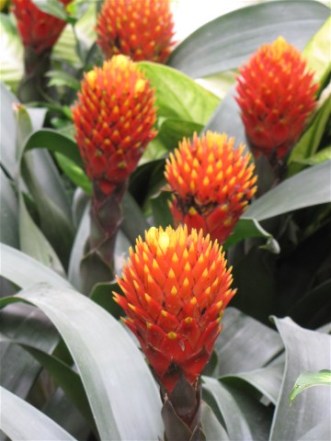The exterior of Tauranga’s Tropical Display House in Cliff Rd doesn’t promise much – it looks more like a shed than a winter garden – but inside you’ll find plenty of colour and a warm, lush atmosphere.

Anthurium scherzerianum. Photo: Sandra Simpson
The building was refurbished at a cost of $50,000 in 2007, putting a stop to it raining inside when it was raining outside, according to then contractor Jayne Ward, of Floragrow Nursery in Te Puna, who tended the plants daily on behalf of Tauranga City Council for about 20 years. The current contractor being Liani Smith of Aztec Gardens (see the post below – Slasher council – to read about the possible closure of the display house).
Over the years the building has gone from being mostly a display of tuberous begonias on display benches to a regularly changed display that includes inground plantings and an orchid cabinet to show the collection of Les Cannon.
“Mr Cannon was headmaster at Tauranga Intermediate and a member of the orchid society,” Jayne says. “He donated his collection to the council more than 30 years ago and since then it has been extended and added to.”
The orchids are kept behind glass for two reasons. One is to stop light-fingered visitors taking them and the other is to try to keep them from insects so the perfect flowers are on show for as long as possible – once an insect pollinates a flower it turns brown and drops.

The fascinating foliage of Pilea involucrata Moon Valley. Photo: Sandra Simpson
The house, which is between the Rose Gardens and historic Monmouth Redoubt, is kept at about 18degC thanks to an underground boiler system added in 2007. Plants on display include Tillandsias (air plants), Nepenthes (carnivorous pitcher plants), Hoyas, palms, ferns, bromeliads, succulents and tropical foliage plants.
Ned Nicely was parks co-ordinator at Tauranga City Council until the end of 2013 and was a true champion of the Tropical Display House.
“We get more people in the house from cruise ships than we do from Tauranga,” he says. “This is a nice place to come, especially in the winter, but it’s not well advertised.”

Bromeliad flowers. Photo: Sandra Simpson
He describes the Display House as a “sanctuary”. “It truly is a sublime place,” he says. “I guarantee no one walks in and thinks of their in-tray and absolutely no one texts.”
- The Tropical Display House, Cliff Rd, is open 10am-4pm daily April-September; 9am-6pm daily October-March. Entry is free.
The Winter Garden Tradition
Auckland’s Winter Garden pavilions were built after World War 1 and gave the Queen City a pair of glasshouses in the style of Kew Gardens, albeit on a much smaller scale.
The complex, near Auckland Museum, is now a protected heritage site and comprises a matching pair of houses (one for temperate plants, one for tropical) with a formal courtyard and pond linking them, and an adjacent fernery.
A $3 million restoration of the site began in 2001 with the Tropical House, the last to be restored, reopening in 2006. Architects Salmond Reed won an award for the work.
There are nearly 2000 plants in the Tropical House, including some not found anywhere else in New Zealand, including the country’s only fruiting cocoa tree and Hernandia bivalvis (grease-nut tree) that is rare in its native Australian rainforest.
The gardens are open year-round and are free to visit.
The Royal Botanic Gardens at Kew in London lay claim to the world’s most important Victorian glass and iron structure with the Palm House, built from 1844-48 by Richard Turner to the design of Decimus Burton. The building, which resembles an upturned ship’s hull, features “head room” for the growing palms. It was completely dismantled, restored and rebuilt from 1984-88.
The Temperate House at Kew, meanwhile, was once the largest plant house in the world and is now the world’s largest Victorian glass structure at 4880 square metres, twice the size of the Palm House. Although ₤10,000 was set aside in 1851 for Burton to design and build it, it wasn’t completed until 1898. It closed in 2013 for a 5-year restoration project.
The oldest glasshouse at Kew dates to 1836, although is hardly recognisable as a glasshouse, featuring a great deal of stone, while the newest is the Alpine House (2006).
Meanwhile, the Royal Greenhouses of Laeken in Brussels, the official residence of the King of Belgium, comprise seven pavilions with a combined floor area of 2.5ha that use over 800,000 litres of fuel a year for heating. They are open to the public for 3 weeks every spring.
This is made up of 2 articles originally published in the Bay of Plenty Times and which appear here with permission.



